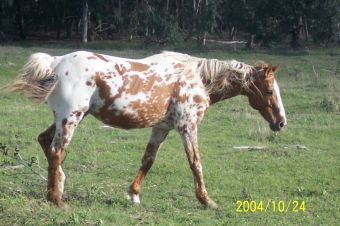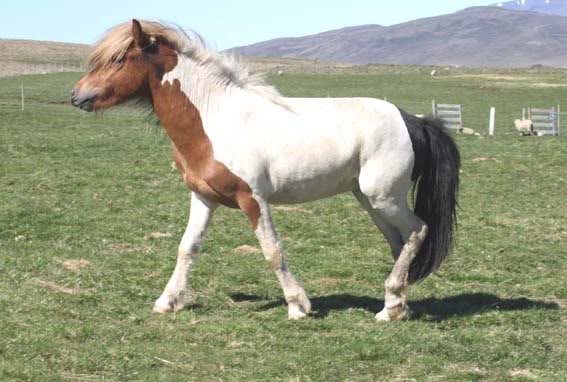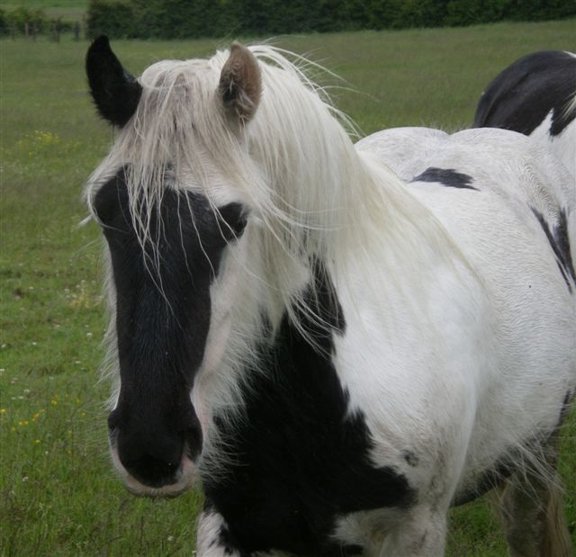So! I realize that this blog is pretty much abandoned, but I figured I may as well write a blog post. First of all, the book Equine Color Genetics by Dan Sponenberg is an *amazing* book. Yes, it is complex (as always will be with genetics of any type), but within the first 15 pages (and skimming through the tons of colored pictures and charts and appendixes) I have learned a lot. So, if you have any interest in learning about horse color genetics, or even just want to figure out the color of your horse, I highly, highly suggest reading it. However, as it is a bit pricey (even from Amazon), I'd suggest checking it out from your local library, as I did.
DISCLAIMER: Yes, even though disclaimers are pesky little bots, I just wanted to say that I have researched/learned about this topic for less than a total of 12 hours, and as it is very complex I could have things wrong. If I mess up on something, can you please make note of it and tell me?
Hmm...I suppose I shall just place a random collection of horsey genetic stuff and information-similar-to-that at this specific locus (aka location). Here goes! :D
- Horse color genetics work fairly simple- each horse has a pair of a specific genes, and when it reproduces with another horse, the foal receives a *random half of a gene from each specific locus from the dam, and same from the sire.
- *Random = not always quite so random when one of the parents is homozygous for a specific gene.
- If you removed all top layers of pigment from the horse, it would not be white. Some people think of a horse as a white canvas with the color on top of that. That is not true. The horse has a base coat of either black or *red, then the other colors are either extensions or dilutes. On top of all that is white patches (either markings or a pinto/Appy pattern).
- *Red (by horse geneticists) is used for either chestnut or sorrel. Saying one of the latter may get you going with a horse breeder about the definition of chestnut vs. the definition of sorrel (when genetically they're the same). And it gets even worse when certain breed regulations call some horses a chestnut if they are of a darker coat with silver-toned mane and tail, whereas they call a sorrel a yellow or gold-toned horse. And then some breeds only use the term chestnut (such as with Arabians) whereas some only use the word sorrel (as with Quarter Horses, I'm pretty sure). So instead, just use red. ;)
- There are basically 14 layers of horse colors. It starts with a base coat of either red (ee) or black (Ee or EE). After that comes the layer that, if the base coat is black, defines the amount of black. For this second layer, AA or Aa limits the black to a horse's points, whereas aa doesn't restrict the black at all, and the horse will just be black. After that comes the cream gene, the dun gene, the champagne gene, and so forth. For a complete list of abbreviations of alleles, the 14 genes, and their affect on a horse, see Wikipedia's article on this.
- Did you know that there is an actual Mushroom horse color gene? Apparently this is a newly discovered dilution gene, and looks quite makes an affect quite similar to the Silver gene. This is gene is still hardly understood, and a main fact of that is probably that most people confuse their Mushroom horses for Silver horses. Whereas, if they DNA tested their horses the owners' would find that their horse came up negative for the Silver gene.
- Also, there are some pretty rockin' awesome horse color modifiers out there! :D This webpage is pretty information-filled (and picture-filled) and if you love horses, you'll love this.
 |
| A manchado horse |
 |
| I was going to be chestnut, but decided to change to black last minute. |

No comments:
Post a Comment